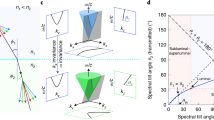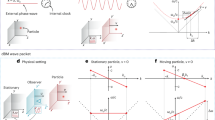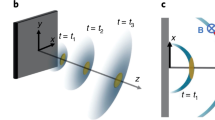Abstract
One consequence of the special theory of relativity is that no signal can cause an effect outside the source light cone, the space-time surface on which light rays emanate from the source1. Violation of this principle of relativistic causality leads to paradoxes, such as that of an effect preceding its cause2. Recent experiments on optical pulse propagation in so-called ‘fast-light’ media—which are characterized by a wave group velocity υg exceeding the vacuum speed of light c or taking on negative values3—have led to renewed debate about the definition of the information velocity υi. One view is that υi = υg (ref. 4), which would violate causality, while another is that υi = c in all situations5, which would preserve causality. Here we find that the time to detect information propagating through a fast-light medium is slightly longer than the time required to detect the same information travelling through a vacuum, even though υg in the medium vastly exceeds c. Our observations are therefore consistent with relativistic causality and help to resolve the controversies surrounding superluminal pulse propagation.
This is a preview of subscription content, access via your institution
Access options
Subscribe to this journal
Receive 51 print issues and online access
$199.00 per year
only $3.90 per issue
Buy this article
- Purchase on Springer Link
- Instant access to full article PDF
Prices may be subject to local taxes which are calculated during checkout



Similar content being viewed by others
References
Jackson, J. D. Classical Electrodynamics 3rd edn, Sec. 11.3.C (John Wiley & Sons, New York, 1999)
Garrison, J. C., Mitchell, M. W., Chiao, R. Y. & Bolda, E. L. Superluminal signals: causal loop paradoxes revisited. Phys. Lett. A 245, 19–25 (1998)
Boyd, R. W. & Gauthier, D. J. in Progress in Optics (ed. Wolf, E.) Vol. 43, 497–530, Ch. 6 (Elsevier, Amsterdam, 2002)
Nimtz, G. & Gaibel, A. Basics of superluminal signals. Ann. Phys. 11, 163–171 (2002)
Chiao, R. Y. & Steinberg, A. M. in Progress in Optics (ed. Wolf, E.) Vol. 37, 345–405, Ch. 6 (Elsevier Science, Amsterdam, 1997)
Agrawal, G. P. Nonlinear Fiber Optics 3rd edn, Ch. 1 (Academic, San Diego, 2001)
Born, M. & Wolf, E. Principles of Optics 7th edn, Sec. 2.3.4 (Cambridge Univ. Press, Cambridge, 1999)
Garrett, C. G. B. & McCumber, D. E. Propagation of a Gaussian light pulse through an anomalous dispersion medium. Phys. Rev. A. 1, 305–313 (1970)
Brillouin, L. Wave Propagation and Group Velocity Ch. I (Academic, New York, 1960)
Sommerfeld, A. Über die fortpflanzung des lichtes in dispergierenden medien. Ann. Phys. 44, 177–202 (1914); English translation available in Brillouin, L. Wave Propagation and Group Velocity Ch. II (Academic, New York, 1960).
Brillouin, L. Über die fortpflanzung des lichtes in dispergierenden medien. Ann. Phys. 44, 203–240 (1914); English translation available in Brillouin, L. Wave Propagation and Group Velocity Ch. III (Academic, New York, 1960).
Chu, C. & Wong, S. Linear pulse propagation in an absorbing medium. Phys. Rev. Lett. 48, 738–741 (1982)
Ségard, B. & Macke, B. Observation of negative velocity pulse propagation. Phys. Lett. 109, 213–216 (1985)
Peatross, J., Glasgow, S. A. & Ware, M. Average energy flow of optical pulses in dispersive media. Phys. Rev. Lett. 84, 2370–2373 (2000)
Wang, L. J., Kuzmich, A. & Dogariu, A. Gain-assisted superluminal light propagation. Nature 406, 277–279 (2000)
Akulshin, A. M., Cimmino, A. & Opat, G. I. Negative group velocity of a light pulse in cesium vapor. Quantum Electron. 32, 567–569 (2002)
Bigelow, M. S., Lepeshkin, N. N. & Boyd, R. W. Superluminal and slow light propagation in a room-temperature solid. Science 301, 200–202 (2003)
Cao, H., Dogariu, A. & Wang, L. J. Negative group delay and pulse compression in superluminal pulse propagation. IEEE J. Sel. Top. Quantum Electron. 9, 52–58 (2003)
Macke, B. & Ségard, B. Propagation of light-pulses at a negative group velocity. Eur. Phys. J. D 23, 125–141 (2003)
Steinberg, A. M. & Chiao, R. Y. Dispersionless, highly superluminal propagation in a medium with a gain doublet. Phys. Rev. A. 49, 2071–2075 (1994)
Harris, S. E. Electromagnetically induced transparency. Phys. Today 50, 36–42 (1997)
Stenner, M. D. & Gauthier, D. J. Pump-beam-instability limits to Raman-gain-doublet “fast-light” pulse propagation. Phys. Rev. A. 67, 063801 (2003)
Diener, G. Superluminal group velocities and information transfer. Phys. Lett. A 223, 327–331 (1996)
Wynne, K. Causality and the nature of information. Opt. Commun. 209, 85–100 (2002)
Mitchell, M. W. & Chiao, R. Y. Negative group delay and “fronts” in a causal system: An experiment with very low frequency bandpass filters. Phys. Lett. A 230, 133–138 (1999)
Nakanishi, T., Sugiyama, K. & Kitano, K. Demonstration of negative group delays in a simple electronic circuit. Am. J. Phys. 70, 1117–1121 (2002)
Solli, D., Chiao, R. Y. & Hickmann, J. M. Superluminal effects and negative group delays in electronics, and their applications. Phys. Rev. E 66, 056601 (2002)
Kuzmich, A., Dogariu, A., Wang, L. J., Milonni, P. W. & Chiao, R. Y. Signal velocity, causality, and quantum noise in superluminal light pulse propagation. Phys. Rev. Lett. 86, 3925–3929 (2001)
Caves, C. M. & Drummond, P. Quantum limits on bosonic communication rates. Rev. Mod. Phys. 66, 481–537 (1994)
Acknowledgements
M.D.S. and D.J.G. acknowledge discussions with M. Gehm and J. Thomas, the loan of an argon-ion pump laser from J. Thomas, and the financial support of the US National Science Foundation.
Author information
Authors and Affiliations
Corresponding author
Ethics declarations
Competing interests
The authors declare that they have no competing financial interests.
Rights and permissions
About this article
Cite this article
Stenner, M., Gauthier, D. & Neifeld, M. The speed of information in a ‘fast-light’ optical medium. Nature 425, 695–698 (2003). https://doi.org/10.1038/nature02016
Received:
Accepted:
Issue Date:
DOI: https://doi.org/10.1038/nature02016
This article is cited by
-
Stability bounds on superluminal propagation in active structures
Nature Communications (2022)
-
Physical limitations on broadband invisibility based on fast-light media
Nature Communications (2021)
-
Free-space optical delay line using space-time wave packets
Nature Communications (2020)
-
Phase-locked laser-wakefield electron acceleration
Nature Photonics (2020)
-
Studies on anomalous dispersion behavior of PANI–CNT composites for enhanced shielding effectiveness in various microwave bands
Applied Physics A (2020)
Comments
By submitting a comment you agree to abide by our Terms and Community Guidelines. If you find something abusive or that does not comply with our terms or guidelines please flag it as inappropriate.



